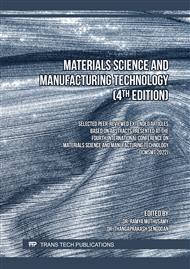[1]
R.T. Loto, P. Babalola, Corrosion polarization behavior and microstructural analysis of AA1070 aluminium silicon carbide matrix composites in acid chloride concentrations, Cogent Eng. 4(1) (2017) 1422229. http://doi.org/10.1080/23311916.2017.1422229.
DOI: 10.1080/23311916.2017.1422229
Google Scholar
[2]
J. Kruger, S. Begum Corrosion of Metals: Overview, Reference Module in Materials Science and Materials Engineering Elsevier Inc., Amsterdam, (2016).
DOI: 10.1016/b978-0-12-803581-8.02708-9
Google Scholar
[3]
Z. Ahmad, Selection of materials for corrosive environment, Principles of Corrosion Engineering and Corrosion Control Chapter 9, 2006, pp.479-549.
DOI: 10.1016/b978-075065924-6/50010-6
Google Scholar
[4]
W. Renpu, Chapter 11 - Oil and Gas Well Corrosion and Corrosion Prevention, Advanced Well Completion Engineering, 2011, pp.617-700.
DOI: 10.1016/b978-0-12-385868-9.00018-x
Google Scholar
[5]
P.K. Bhowmik, E. Hossain, J.A. Shamim, Corrosion and its control in crude oil refining process, Institute of Engineers, Bangladesh, (2000).
Google Scholar
[6]
G. Koch, J. Verney, N. Thompson, O. Moghissi, M. Gould, J. Payer, International methods of prevention, application and economics of corrosion technologies study, NACE International, Texas, (2016).
Google Scholar
[7]
Popov BN 2015 Corrosion Inhibitors, Corrosion Engineering Principles and Solved Problems Elsevier Inc., Amsterdam, Chapter 14, 2015, pp.581-597.
Google Scholar
[8]
G. Palanisamy, Corrosion Inhibitors IntechOpen, (2018).
Google Scholar
[9]
V.S. Sastri, Types of corrosion inhibitor for managing corrosion in underground pipelines, Underground Pipeline Corrosion, Elsevier Inc., Amsterdam, Chapter 6, 2014, pp.166-211.
DOI: 10.1533/9780857099266.1.166
Google Scholar
[10]
Y. Chen, W. Yang, Formulation of Corrosion Inhibitors, IntechOpen, (2019).
Google Scholar
[11]
C.G. Dariva, A.F. Galio, Corrosion Inhibitors – Principles, Mechanisms and Applications IntechOpen, (2013).
Google Scholar
[12]
S.K. Ahmed, W.B. Ali, A.A. Khadom, Synthesis and investigations of heterocyclic compounds as corrosion inhibitors for mild steel in hydrochloric acid, Int. J. Ind. Chem. 10 (2019) 159–173.
DOI: 10.1007/s40090-019-0181-8
Google Scholar
[13]
A. Singh, M. Talha, X. Xu, Z. Sun, Y. Lin, Heterocyclic corrosion inhibitors for J55 steel in a sweet corrosive medium ACS Omega 2(11) (2017) 8177-8186.
DOI: 10.1021/acsomega.7b01376
Google Scholar
[14]
A. Singh, K.R. Ansari, M.A. Quraishi, S. Kaya, P. Banerjee, The effect of an N-heterocyclic compound on corrosion inhibition of J55 steel in sweet corrosive medium, New J. Chem. 43 (2019) 6303-6313.
DOI: 10.1039/c9nj00356h
Google Scholar
[15]
R.G. Sundaram, M. Sundaravadivelu, Anticorrosion Activity of 8-Quinoline Sulphonyl Chloride on Mild Steel in 1 M HCl Solution, Journal of Metallurgy, 8095206 (2016). https://doi.org/10.1155/2016/8095206.
DOI: 10.1155/2016/8095206
Google Scholar
[16]
R.T. Loto, Study of the synergistic effect of 2-methoxy-4-formylphenol and sodium molybdenum oxide on the corrosion inhibition of 3CR12 ferritic steel in dilute sulphuric acid, Results in Phys. 7 (2017) 769-776.
DOI: 10.1016/j.rinp.2017.01.042
Google Scholar
[17]
C.A. Loto, R.T. Loto, Effect of dextrin and thiourea additives on the zinc electroplated mild steel in acid chloride solution, Int. J. Elect. Sci. 8(12) (2013) 12434-12450.
Google Scholar
[18]
R.T. Loto, C.A. Loto, Effect of P-phenylediamine on the corrosion of austenitic stainless steel type 304 in hydrochloric acid, Int. J. Elect. Sci. 7(1) (2012) 9423-9440.
DOI: 10.1007/s12633-015-9344-1
Google Scholar
[19]
R. Leramo, B. Oyebade, Synergistic combination effect of salvia officinalis and lavandula officinalis on the corrosion inhibition of low-carbon steel in the presence of SO42−- and Cl−-containing aqueous environment, J. Fail. Anal. Prev. 18(6) (2018) 1429-1438.
DOI: 10.1007/s11668-018-0535-0
Google Scholar
[20]
R.T. Loto, E. Oghenerukewe, Inhibition studies of rosmarinus officinalis on the pitting corrosion resistance 439LL ferritic stainless steel in dilute sulphuric acid, Orient. J. Chem. 32(5) (2016) 2813-2832.
DOI: 10.13005/ojc/320557
Google Scholar
[21]
C.A. Loto, R.T. Loto, A.P.I. Popoola, Effect of neem leaf (azadirachita indica) extract on the corrosion inhibition of mild steel in dilute acids, Int. J. Phy. Sci. 6(9) (2011) 2249-2257.
DOI: 10.17159/0379-4350/2015/v68a16
Google Scholar
[22]
J.O. Bockris, D.A.J. Swinkels, Adsorption of n-decylamine on solid metal electrodes, J. of Elect. Soc. 111(6) (1964) 736.
DOI: 10.1149/1.2426222
Google Scholar
[23]
K. Vijayaraghavan, T.V.N. Padmesh, K. Palanivelu, M. Velan, Biosorption of nickel (II) ions onto Sargassum wightii: Application of two-parameter and three parameter isotherm models, J. Hazard. Mater. B133 (2006) 304–308.
DOI: 10.1016/j.jhazmat.2005.10.016
Google Scholar
[24]
J. Zeldowitsch, Adsorption site energy distribution, Acta Phys. Chim. URSS 1 (1934) 961–973.
Google Scholar



